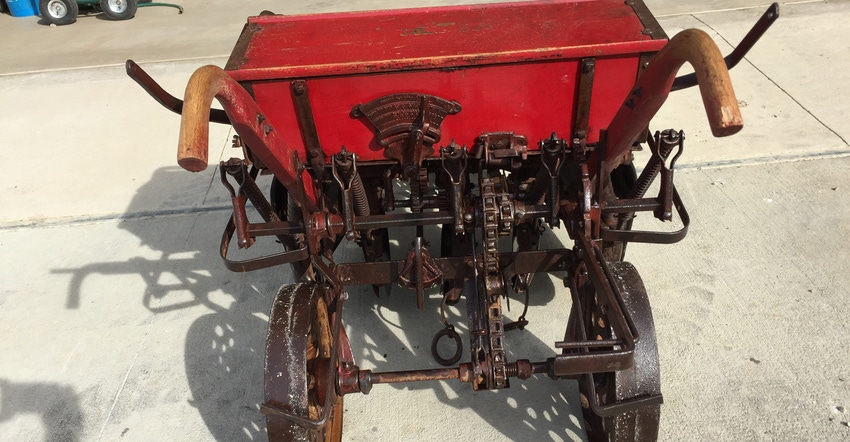May 25, 2017

There is a farmer in central Indiana today —probably more than one — who pulls a high-clearance spray rig with a price tag well above $200,000 into standing corn in early September to seed rye or other cover crops. He could seed wheat if he wanted. The idea is to get an early start for the cover crop. Some people use autosteer to guide their rig. Others have a camera mounted in the cab to see if the seed is feeding through the seeder and how well the process is working.
It all sounds high-tech, and it is. However, Albert Ferris, Milton, was doing similar things in the 1930s and ’40s. He was seeding the wheat as a crop, and he was using horses. But he was interseeding. He was also practicing the most rudimentary form of autosteering! Remember, truth can be stranger than fiction.
Thanks to Jeff Boyer, superintendent of the Davis-Purdue Agricultural Center, for providing information about Ferris’ accomplishments. His descendants, Jonathan Ferris and family, donated the equipment Ferris used to Purdue University. The one-horse McCormick and Dowagiac grain drills will be on display when Davis-Purdue celebrates its 100th anniversary this summer. A field day is planned for Aug. 31 at the center near Farmland.
Cutting edge?
According to Boyer, at one time Ferris used both of these drills to seed wheat into standing corn in September. Both drills had grass seed attachments, a grain box, a fertilizer box and a metal skirt in front of the rolling disks so it would go through rows better. Remember, this was when corn was typically planted in 40-inch rows.
Ferris ran one drill behind one horse for many years. He walked behind, holding the big wooden handles. Here’s where things become interesting!
As the story goes, he later bought a second drill and ran two horses, one in each row. He stood behind one drill and used voice commands to start and stop the team of horses. They were used to walking together for most field chores, so they apparently didn’t know the difference between being hitched together and just walking next to each other. It doubled Ferris’ labor efficiency.
And you thought autosteering and autonomous vehicles were modern phenomenons! I contend that the reason many Hoosiers are so inventive today with modern technology is because they inherited the ability to find better solutions from their ancestors. Boyer contends horses were the technology of the day, and after hearing this tale, who can argue?
Just like with autosteer — until 2017, that is — Ferris had to stop on the ends, take each horse by the halter, and turn it into the next set of two rows. He typically worked with a pair of Percheron mares.
The disclaimer “until 2017” is there because a new innovation, NextSwath, makes it possible to use autosteer throughout the field, push a button, and let the tractor turn itself. Boyer used this technology successfully while planting corn on the Davis-Purdue farm this spring.
So we use breakthrough technology today — really? Or is it just old ideas recycled and refined? Here’s to the creativity of early Hoosier farmers and innovators!
You May Also Like




